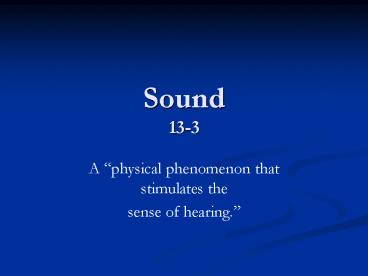Sound 13-3 PowerPoint PPT Presentation
1 / 15
Title: Sound 13-3
1
Sound13-3
- A physical phenomenon that stimulates the
- sense of hearing.
2
What do you think?
- A violin, a trumpet, and a clarinet all play the
same note, a concert A. However, they all sound
different. - What is the same about the sound?
- Are the frequencies produced the same?
- Are the wave patterns the same?
- Why do the instruments sound different?
3
Standing Waves
- Standing waves are produced when two identical
waves travel in opposite directions and
interfere. - Interference alternates between constructive and
destructive. - Nodes are points where interference is always
destructive. - Antinodes are points between the nodes with
maximum displacement.
4
Standing Waves on a String
- There is a node at each end because the string is
fixed at the ends. - The diagram shows three possible standing wave
patterns. - Standing waves are produced by interference as
waves travel in opposite directions after
plucking or bowing the string. - The lowest frequency (one loop) is called the
fundamental frequency (f1).
5
Standing Waves on a String
- To the left is a snapshot of a single loop
standing wave on a string of length, L. - What is the wavelength for this wave?
- Answer ? 2L
- What is the frequency?
- Answer
6
(No Transcript)
7
Harmonics
- n is the number of loops or harmonic number.
- v is the speed of the wave on the string.
- Depends on tension and density of the string
- L is the length of the vibrating portion of the
string. - How could you change the frequency (pitch) of a
string?
8
Fundamental Frequency
Click below to watch the Visual Concept.
Visual Concept
9
Standing Waves in an Air Column
- Wind instruments also use standing waves.
- Flutes, trumpets, pipe organs, trombones, etc.
- Some instruments have pipes open at both ends
while others have one end closed. - Air is free to move at open ends so antinodes
occur. - Closed ends are nodes.
- The velocity of the wave is now the velocity of
sound in air (346 m/s at 25C).
10
Both Ends Open
11
Closed at One End
12
Wind Instruments
- Wind instruments are not as simple as organ
pipes. - The shape is not always cylindrical.
- The holes change the wave patterns as well.
- The size of the pipe varies along the length.
13
Practice Problems
- One string on a toy guitar is 34.5 cm long.
- What is the wavelength of the first harmonic or
the fundamental wavelength? - Answer 69.0 cm or 0.690 m
- The string is plucked and the speed of the waves
on the string is 410 m/s. What are the
frequencies of the first three harmonics? - 590 Hz, 1200 Hz, 1800 Hz
- Note The use of significant figures causes the
multiples of 590 to be 1200 and 1800 because only
two significant figures are present in the answer.
14
Practice Problems
- An organ pipe open at both ends is 34.5 cm long.
- What is the wavelength of the first harmonic or
the fundamental wavelength? - Answer 69.0 cm or 0.690 m
- What are the frequencies of the first three
harmonics if the air temperature is 25.0C? - Answers 501 Hz, 1000 Hz, 1500 Hz
- Answer the same questions if the pipe is closed
at one end. - Answers 251 Hz, 753 Hz, 1250 Hz
15
Practice Problems
- A violin string that is 50.0 cm long has a
fundamental frequency of 440 Hz. What is the
speed of the waves on this string?

